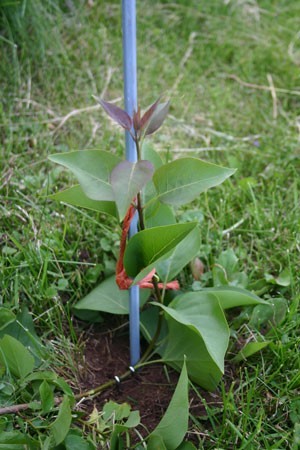 Layering is one of the easiest ways to propagate plants-especially if you're looking to fill gaps in hedges, fill in specific areas with shrubs or re-root leggy plants. New roots grow on the stem of the parent plant while it remains firmly planted in the ground receiving nutrients.
Layering is one of the easiest ways to propagate plants-especially if you're looking to fill gaps in hedges, fill in specific areas with shrubs or re-root leggy plants. New roots grow on the stem of the parent plant while it remains firmly planted in the ground receiving nutrients.
Tip Layering: In late summer, select a branch that has a tip containing this year's growth. Dig a small, 4-inch deep hole and bend the branch so you can pin the tip into the soil. Use a small peg, some wire or a good sized rock to pin the tip in place. Cover the hole with dirt and water. A new shoot should appear within just a few weeks, and by late fall the new seedling should be ready for transplanting. Simply dig it up, clip free the portion leading to the parent plant and move it to the desired location. You can also wait and transplant it in the early spring.
Simple Layering: This method of layering is usually done in the early spring or late fall when plants are dormant. Select a 1-year old branch and make a 1/2 to 3/4 inch cut through the stem 3 to 5 inches from the tip. Dig a shallow depression in the ground and bend the branch so that the portion of the stem containing the cut can be pinned into the soil. Insert a small pebble or toothpick into the cut to keep it open and if desired, apply a rooting hormone. (Hint: if you use a grain of wheat, when it germinates, it will release hormones that promote rooting.) Secure the tip end of the stem to a small stake so it remains upright and secure the cut portion into the soil with a piece of bent wire or a small peg.
Serpentine Layering: This method of layering is really just a variation of Simple Layering, only a single, long flexible stem is pegged down to the soil every few inches. The result is a stem that looks like the body of a serpent (think Loch Ness Monster). The advantage to this variation is that a single stem can produce several new plants at one time.
Air Layering: Try this method if you have a thick-stemmed houseplant or patio plant that has lost its lower leaves and has become leggy. If you're air layering in the spring, select a stem containing the previous year's growth. If you're air layering in the summer, select a stem containing this year's growth, but one that hasn't yet turned hard and woody. Make an upward slit in the stem, no more than 2 feet from the tip of the plant. Leaf growth will occur above the point of layering, so choose a spot on the stem where you want the soil level to be. Instead of a slit, you can also strip 1/2 inch circle of bark from around the stem. Apply a rooting hormone to the cut/stripped area.
Layering Saplings: Whole trees and shrubs that are at least 1-year old can be layered in trenches. Simply bend them over and lay them in a pre-dug trench in the early spring, as soon as the tree becomes pliable. Pin the sapling down in the trench, but don't cover it. As the stems begin to grow upward and develop leaves, gradually cover the stem of the parent tree with soil.
blackberry, loganberry and raspberry (tip layering); barbarry, clematis, dieffenbachia, lilac, magnolia, rhododendron, viburnum and wisteria (simple layering); azalea, dieffenbachia, magnolia, philodendron and rubber plants (air layering).